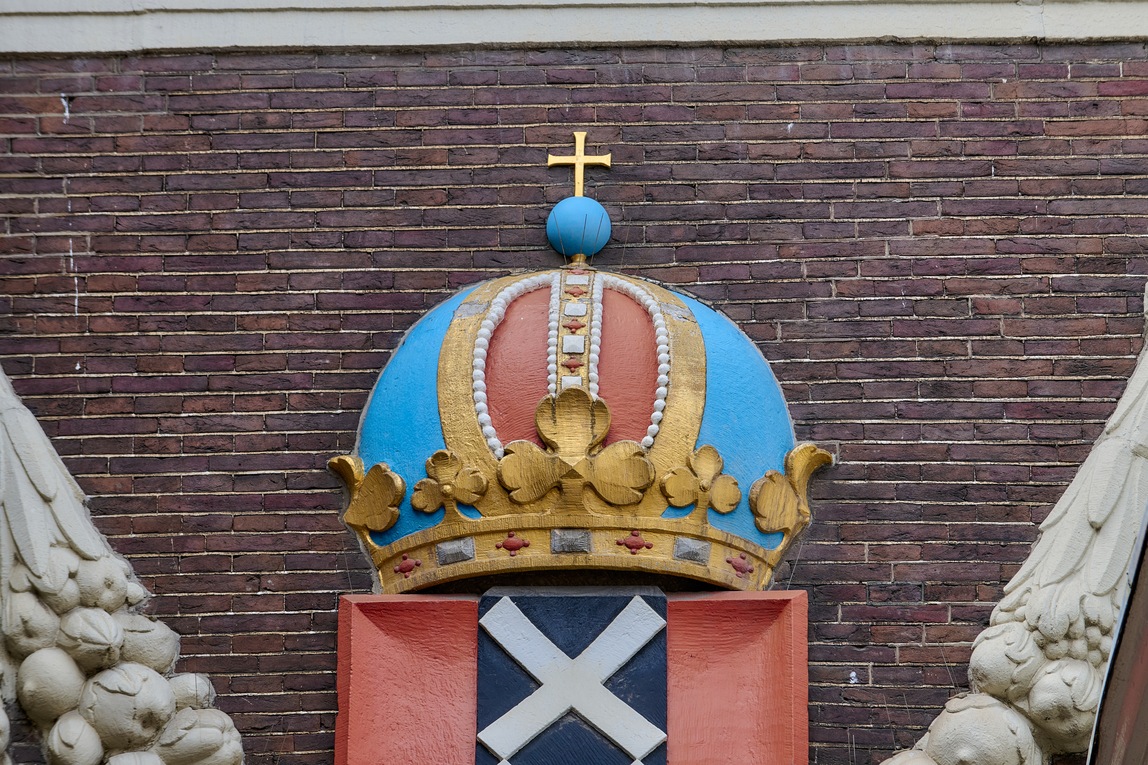About the dynamics of the crown in the Amsterdam city coat of arms.
Location
Burgerweeshuis
Sint Luciënsteeg
Type
Orphanage
Religious community
Roman Catholic Church
Object
City coat of arms above the gate of the former Burgerweeshuis.
Maker and date
Maker unknown
1602
Visit
Visible from the St.-Luciënsteeg
The gate of the former Burgerweeshuis proudly displays the city coat of arms that was placed there in 1642. Above the three St. Andrew's crosses, an imperial crown is placed very prominently. You will find a crown in many places in Amsterdam. It is often said that this is the crown of Emperor Maximilian I (1459-1519), Emperor of the Holy Roman Empire from 1508.
Two different explanations are given as to why Amsterdam was given the right to use the crown in the city coat of arms. The first explanation is that Maximilian became seriously ill in 1489 during a visit to The Hague. He then promises God that he will visit the Kapel ter Heilige Stede in Amsterdam if he recovers. Maximilian recovers and is so grateful for this that he gives Amsterdam permission to use his crown in the city coat of arms.
A second, historically more plausible explanation is that Amsterdam granted Emperor Maximilian a substantial loan at the end of 1488, after having helped him financially a few years earlier. For that reason, Maximilian had large annual (financial) obligations to the city in those years. In return, Maximilian granted Amsterdam the privilege of including his crown in the city's coat of arms. Because Maximilian was then king, and not (yet) emperor, the crown that the city was allowed to wear was a royal crown. However, when Maximilian was crowned emperor in 1508, the city replaced the royal crown in the city's coat of arms with the imperial crown.
Amsterdam briefly threatened to lose the crown again when Filips de Schone, Maximilian's son, withdrew all the privileges granted by his father, but after a substantial financial contribution, Amsterdam was allowed to continue to use the crown in the city's coat of arms. Maximilian's grandson, Emperor Rudolf II, had a new imperial crown designed and Amsterdam also immediately adapted the crown in the city's coat of arms. This imperial crown can now be found in various places in Amsterdam, such as here on the gate and also on the tower of the Westerkerk. Some people regret the loss of Maximilian's crown because it means that a strong and clearly visible connection with the city's Catholic past is disappearing. It is true, says for example Mgr. Klönne (1834-1921), rector of the Begijnhof and founder of the historical circle Amstelkring (now Museum Ons' Lieve Heer op Solder), that the city has become great thanks to the devotion to the Miracle of Amsterdam. For Klönne, there is therefore only one crown, the true crown above the city's coat of arms: that of Maximilian I.
Sarah ter Weijden
Student minor Religieus erfgoed in Amsterdam (Vrije Universiteit/Reinwardt Academie), 2022
August den Hollander
Professor of Religious Heritage
Last edited
March 10, 2025
The crown, detail from the city coat of arms above the gate of the Burgerweeshuis, maker unknown, material: stone, dimensions unknown. Photography Robert Westera.
City coat of arms above the gate of the Burgerweeshuis, maker unknown, material: stone, dimensions unknown. Relief above the gate of the Burgerweeshuis with orphans around the emblem of the Burgerweeshuis, maker Joost Jansz. Bilhamer, material: stone, dimensions unknown. Photography Robert Westera.






